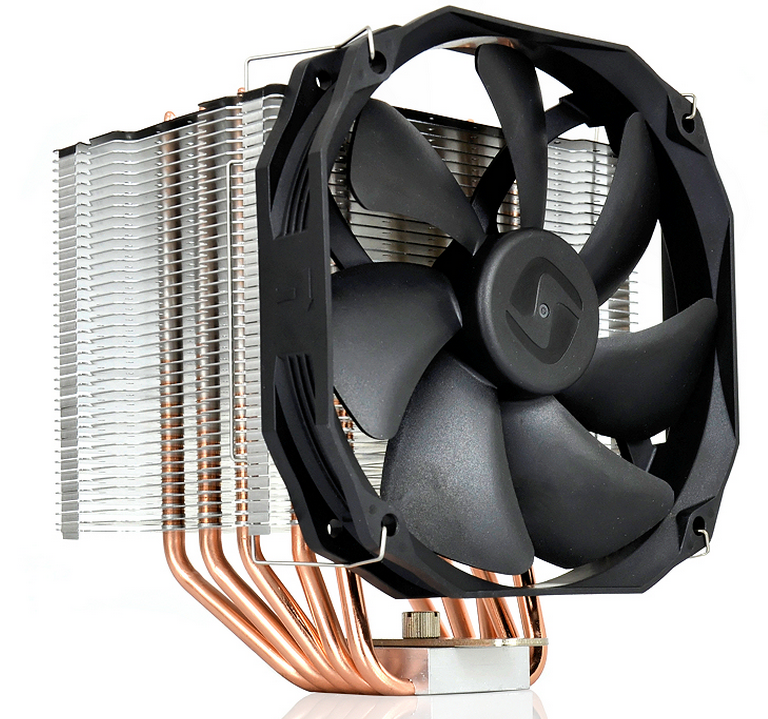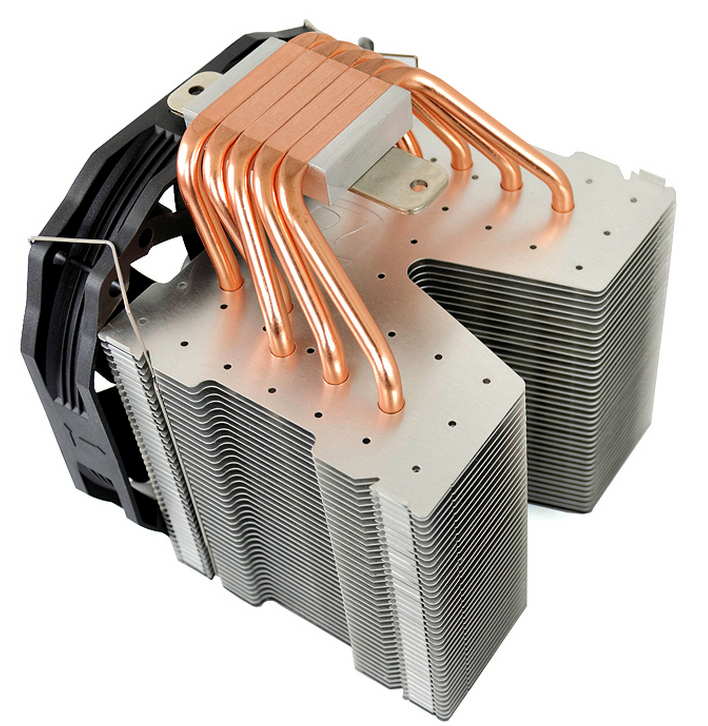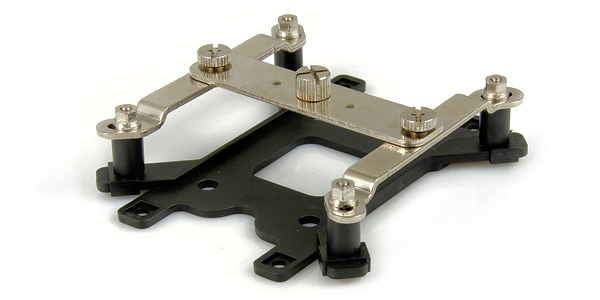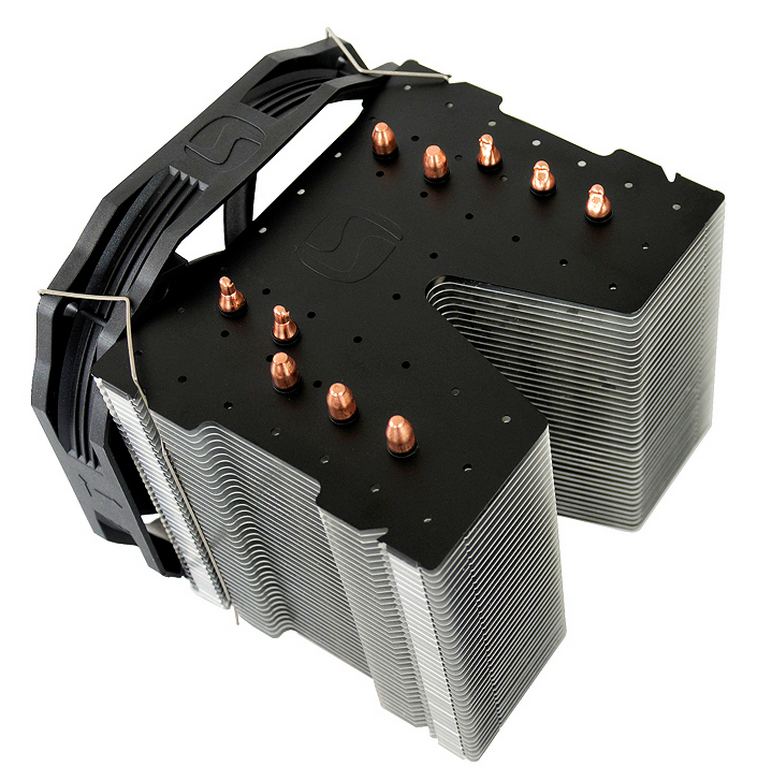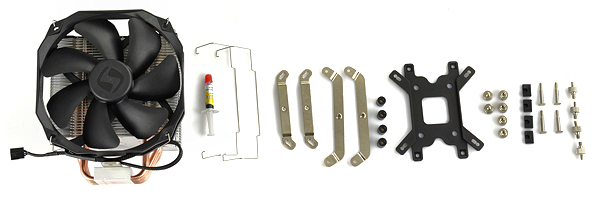SilentiumPC Slides Into High-End Air Cooling With Fortis 3 HE1425
SilentiumPC announced a new high-end CPU air cooler with an interesting design. In the tech world today, we have become accustomed to seeing simple rectangular heatsinks with a series of heatpipes and a fan attached. Each company tends to arrange the heatpipes differently, and sometimes add a second fan, but the overall design remains much the same. Although the Fortis 3 HE1425 is similar to those designs in some ways, it also enjoys a redesigned heatsink, which gives it a unique look and potentially increased cooling performance.
The Fortis 3 HE1425 utilizes a series of five heatpipes, each 6 mm in diameter. The heatsink is symmetrical in design, and SilentiumPC placed the heatpipes into two rows: a row of three, and a row of two. Naturally, the heatpipes meet at the base of the cooler, and make direct contact to the CPU. SilentiumPC did not opt to utilize a solid base plate for cooling. Although the effects of this decision on the unit's cooling performance is questionable, it will prevent customers from utilizing gallium-based TIMs such as Coollaboratory's Liquid Pro, and similar corrosive TIMs.
As with most large high-end air cooling solutions, it is necessary to use a mounting bracket to fasten it securely to the motherboard. The overall design of the mounting mechanism isn't anything special, but the screws utilized are. SilentiumPC took advantage of low-profile mounting screws in an attempt to conserve the height of the cooler.
As anyone who has ever installed a larger air cooler like this knows, the chance that the cooler is too tall to fit inside of your PC case is a very serious concern, and limits the use of this product inside many chassis. This cooler tops out at 158 mm with the fan installed, and although this is only slightly reduced relative to competing air coolers -- Noctua's NH-D15 and Phantek's PH-TC14PE measure 165 mm and 171 mm tall, respectively -- it will still help get the product in places that other 140 mm fan coolers can't go.
This will make mounting the cooler inside of the system more difficult, though. Reaching around larger air coolers to tighten screws is always a difficult task, and as the screws shrink as they do on the Fortis 3, this will likely only be harder.
The fan on the Fortis 3 is a SilentiumPC Sigma Pro 140, a new fan designed specifically for this cooler. Utilizing a new blade design and a max speed of 1400 RPM, it produces a total airflow of 78.6 CFM. It also remains relatively silent while doing so, rated to produce no more than 22 dBA of noise.
Turning to the heatsink utilized, SilentiumPC opted to take a chunk out of the fins; going down the middle of the cooler is a V-shaped groove. It isn't clear why the company did this, but as there are no heatpipes in this sector, it might have been simply to give the cooler a unique look. It could also be that this added material restricted airflow, and removing it increases cooling performance. (It may simply have been an easy way to cut corners on the budget too, though.) Regardless, the 38 layers of aluminum fins are still present around the heatpipes, so cooling performance shouldn't be impaired by this decision.
Get Tom's Hardware's best news and in-depth reviews, straight to your inbox.
The cooler is compatible with all non-server sockets from AMD AM2 and up, and Intel LGA 775 and up. This includes the LGA 2011 socket, which blurs the line between server and desktop. It is also rated for a max TDP of 220 W, indicating that it's compatible with even the hottest running desktop CPUs on the market.
The cooler will go on sale September 10; the MSRP is $34.90 USD.
Follow Michael Justin Allen Sexton @LordLao74. Follow us @tomshardware, on Facebook and on Google+.
-
tiagoluz8 That fan is too big for this cooler, the air takes the path of least resistance, so in this cooler it will flow more to the rest of the case (VRM & RAM) than trough the actual cooler.Reply -
Au_equus ReplyAlthough the effects of this decision on the unit's cooling performance is questionable, it will prevent customers from utilizing gallium-based TIMs such as Coollaboratory's Liquid Pro, and similar corrosive TIMs.
Mike, Ga will not dissolve Cu. It dissolves/corrodes Al. Please correct the above statement. Plenty of companies use bare copper bases or may have a passive CuO/Cu2O layer, preventing further oxidation, on the base of their respective heatsinks.
http://www.coollaboratory.com/pdf/manual_liquid_ultra_englisch.pdf -
IInuyasha74 Reply16495652 said:Although the effects of this decision on the unit's cooling performance is questionable, it will prevent customers from utilizing gallium-based TIMs such as Coollaboratory's Liquid Pro, and similar corrosive TIMs.
Mike, Ga will not dissolve Cu. It dissolves/corrodes Al. Please correct the above statement. Plenty of companies use bare copper bases or may have a passive CuO/Cu2O layer, preventing further oxidation, on the base of their respective heatsinks.
http://www.coollaboratory.com/pdf/manual_liquid_ultra_englisch.pdf
This is not a mistake. I know that gallium will not cause any problems on copper, but when direct copper tubs such as this are used to make contact the CPU, there are always little bits of aluminum at risk too. You can see the small lines between the tubes, and on the edges of the pad. It doesn't take much gallium to get in there to cause the bits of aluminum holding the pipes in place to start to break down, and ultimately cause the pipes to shift, or the base to fall apart.
I personally use Liquid Metal Pro in all of my systems, which is the reason I pointed out this detail. Most skip over it and consider it to be acceptable. I don't, however, and only buy coolers that either have a solid copper or nickel-plated base to avoid this issue. -
alidan Reply16495652 said:Although the effects of this decision on the unit's cooling performance is questionable, it will prevent customers from utilizing gallium-based TIMs such as Coollaboratory's Liquid Pro, and similar corrosive TIMs.
Mike, Ga will not dissolve Cu. It dissolves/corrodes Al. Please correct the above statement. Plenty of companies use bare copper bases or may have a passive CuO/Cu2O layer, preventing further oxidation, on the base of their respective heatsinks.
http://www.coollaboratory.com/pdf/manual_liquid_ultra_englisch.pdf
This is not a mistake. I know that gallium will not cause any problems on copper, but when direct copper tubs such as this are used to make contact the CPU, there are always little bits of aluminum at risk too. You can see the small lines between the tubes, and on the edges of the pad. It doesn't take much gallium to get in there to cause the bits of aluminum holding the pipes in place to start to break down, and ultimately cause the pipes to shift, or the base to fall apart.
I personally use Liquid Metal Pro in all of my systems, which is the reason I pointed out this detail. Most skip over it and consider it to be acceptable. I don't, however, and only buy coolers that either have a solid copper or nickel-plated base to avoid this issue.
a good point that is a non issue to almost anyone.
that said cant wait to see someone do benches on this. im putting together parts for my next computer soon and want it to come in under 1500$ if possible, cheaper but fantastic parts are better to be than the best of the best. -
synphul Bench's would be nice at some point. I don't think the v-groove in the fins is an issue, most of the heat is cooled directly from the heat pipes and just a bit to the fins attached. I highly doubt much heat under constant airflow radiates all the way across all those fins (of any cooler) into the center, the furthest point from the heat pipes. Not only do they likely save money on materials it also keeps the weight down.Reply
It looks like they went to the trouble to shift the heat pipes and mass of the cooler to one side similar to the cryorig h7. Does it have the same 0 ram conflict with intel boards? Not sure how much of an issue it was with amd boards, if their ram was just as subject to interference from coolers like the 212 evo. If I'm not mistaken the same layout was used on the new z170 boards as the lga1155/1150 boards.
Also nice they chose to blackout the top of the cooler, quite a few folks with windowed cases who try to avoid the look of plain metal and black is pretty universal. -
IInuyasha74 Reply16496707 said:Bench's would be nice at some point. I don't think the v-groove in the fins is an issue, most of the heat is cooled directly from the heat pipes and just a bit to the fins attached. I highly doubt much heat under constant airflow radiates all the way across all those fins (of any cooler) into the center, the furthest point from the heat pipes. Not only do they likely save money on materials it also keeps the weight down.
It looks like they went to the trouble to shift the heat pipes and mass of the cooler to one side similar to the cryorig h7. Does it have the same 0 ram conflict with intel boards? Not sure how much of an issue it was with amd boards, if their ram was just as subject to interference from coolers like the 212 evo. If I'm not mistaken the same layout was used on the new z170 boards as the lga1155/1150 boards.
Also nice they chose to blackout the top of the cooler, quite a few folks with windowed cases who try to avoid the look of plain metal and black is pretty universal.
SilentiumPC provided a photo showing it did not interfere with the RAM on at least one board. However, this varies too much from one motherboard to another. As such, I didn't want to state if it would cause this issue or not, because it won't be accurate in all cases. -
synphul Just hopped over to their website, had only looked at the article pics. Looks like the offset design does in fact work much like the h7's and has 0 ram interference on the 1155/1150/1151 boards. Also made it more apparent the function the 'v' shape notch in the fins provides, access for a screwdriver to reach the cross member mounting screw. Other coolers have done similar but with a hole punched through the various layered fins. They just opted to use the notch.Reply
Looks like they avoided ram interference on the am3+ as well. Not an over the top styled cooler or anything but so far looks like they did their homework and planned pretty well for a universal cooler. Made it a point to outline all the various sockets in the short youtube vids to show compatibility and the install looks pretty painless. Nice use of the clips to keep the mounting pins from backing out once attached to the backplate. By appearances they seem to cover all the bases. Props for that and appears to have an attractive price.
Depending on cooling bench's and noise profile, might be a head to head competitor to cryorig's budget coolers. If so, good news for folks moving the lga1151 since the new skylake cpu's forego the stock cooler. Too early to tell but it may be a new trend moving forward and amd could follow suit with their zen cpu's also. It'll be good to have some more budget minded options for aftermarket coolers if they begin to go this route and builders are required to pick up a cooler rather than just stay with the stock unit. Enthusiasts will most likely opt for higher performance coolers and won't be bothered by the higher prices but folks aren't going to be too happy if they're stuck with moderate to expensive options as their only cooling choices for new chips.
